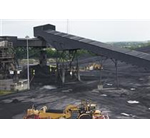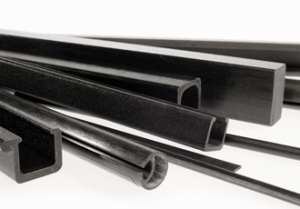Wear Protection Delivers Maximum Roi For Coal Bulk Handling Vessels, Extending Discharge Plant Life & Increasing Throughput
10th November 2011
Source:
Kingfisher Industrial Ltd

Despite the reduction in its use in western countries, coal is still a major fuel worldwide, accounting, together with iron ore, for the majority of ocean-going bulk freight. This global trade poses a major challenge to shippers in handling the various sizes, types and blends of coal, and also in coping with the abrasive characteristics of the fossil fuel. The problem is that coal is high in silica, a mineral that causes erosion and wear, in the plant and equipment used to process it. In the pressurised world of bulk carriers, where coal is handled in quantities of millions- of- tonnes per year, the ramifications of this problem can be very serious, resulting in extended ship layovers if not addressed. Consequently, it makes economic sense to take appropriate measures to protect against the sliding friction and impacts that cause wear.
Wear protection is the process of coating or lining process plant and equipment, such as bunkers, pipework, chutes, cyclones, valves, (et al), with ceramics, metallics or polymers to extend their life. The economic value of the process can be judged by figures from Kingfisher Industrial, a specialist in wear protection across bulk handling industries. The company has calculated that, on average, users of its wear protection systems benefit by a factor of 5 times their initial outlays, with many installations providing wear life of up to 20-years following appropriate wear treatment.
In many instances, the benefits of protecting plant are threefold: in addition to protecting against wear, the low friction nature of the lining material reduces energy usage and allows a greater volume of material to be loaded or discharged, resulting in reduced demurrage costs for port side facilities, and limiting the duration bulk handling vessels spend discharging difficult cargoes such as coal.
Kingfisher has a wealth of experience of providing wear protection on bulk coal handling vessels, including self unloading types.
“The choice of liners to aid discharge and protect structures is an important decision, because not only will it maintain the asset value of the vessel handling equipment. It will also ensure demurrage costs are kept to a minimum by enabling continuous discharge at the desired rate of conveyance,” said Kingfisher MD, John Connolly.
“In addition, installing an optimised lining system reduces the risk of spillages, their consequent environmental impact and clean up costs. It also eliminates the thankless task of equipment repair, and takes away the requirement for crew to enter dangerous and, in some instances, confined spaces in order to undertake cleaning and clearing of material blockages at great risk to themselves and their colleagues.”
Wear protection can be employed at any time in the life of dry bulk handling systems for coal. However, if a system is designed with wear protection from its conception, then overall equipment costs can usually be reduced, as the system chosen to protect the equipment can often remove the requirement to manufacture components using heavier grades of material. In addition, because high conveying speeds and abrasive materials cause wear of varying intensity at different points in dry bulk handling systems, it is often the case that protection need only be applied to areas of plant that are most vulnerable to wear, further reducing upfront costs and improving ROI for the system user.
In common with other bulk materials, the equipment for processing and conveying coal needs to cater for many operational factors. If considered from the onset, these factors can be catered for and a design element introduced to compensate for potential wear problems. Factors such as volumes, loadings, particle size and shape, viscosity and moisture content are typical criteria that must be addressed in order to eliminate potential problem wear areas. Selecting the right liner materials, hopper design and pipe installation can prevent the need for replacement and maintenance for up to 20- years.
“There is no one-size-fits-all philosophy in respect of wear protection, that’s why we always carefully analyse all aspects of the equipment, site and surrounding environment before we put a firm solution proposal before our customer,” said John Connolly.
“What we are aiming to achieve is the longest possible operating life from an installation, to payback the initial investment many times over.”
Kingfisher’s experience also shows that it is more profitable for bulk carrier operators to invest in wear protection rather than having to provide regular maintenance and repair of equipment at frequent intervals. “Reduced maintenance means reduced risk, reduced cost and more production uptime over longer periods – all of which are critically important to improve the efficiencies and ROI of bulk carrier companies operating in competitive markets,” said Connolly.
Some of the vessels on which Kingfisher has provided wear protection are unique in their design, because they use gravity to discharge bulk coal out of the bottom of their cargo holds. Kingfisher has provided wear protection systems to protect the sloping discharge surfaces of the cargo holds, and has protected the conveyor transfer chutes that are positioned within the hull and on the deck discharge conveyor system.
Within the conveyor network below the cargo holds, material is handled and transferred through chutes that discharge the material into reception hoppers on-shore, or, alternatively, load directly into smaller vessels that can navigate into estuaries or inland water ways. Due to exceptionally high tonnage rates handled by the conveyor system, the design and protection of the system is of utmost importance in order to maintain its integrity and operating efficiency. Protecting this equipment using a range of ceramic, polymer or metallic liners is of utmost importance. Here, Kingfisher has had significant success using its K-ALOX ceramic liners. These counter the effects of handling materials with very abrasive characteristics, such as coal, coke and iron, which, due to the hardness of the mineral, degrade the surface of equipment used to convey them. During discharge, the importance of reliable effective materials handling equipment makes the difference in earning or losing money, as slow discharge rates, due to a vessel’s inability to unload at an agreed tonnage rate, cost operators income.
Kingfisher has produced a graphic to highlight the benefits of its wear protection systems The graphic compares the ongoing costs associated with equipment and installations that do not benefit from wear protection, with the one-off (i.e. purchase) costs of enhanced protection, highlighting the continuous operational gains of the latter investment strategy.
The thrust of the argument is clear when considering the typical example of an enclosed pipework system for conveying bulk materials. The system is wear protected, and so is able to provide up to 20-years of life.
With this one-off approach, the system user has little or no maintenance requirements over the lifetime of the installation. He does not have the ongoing cost problem – say every 4-years - of breaking the pipework system down - and of interrupting production in the process.
Kingfisher solves wear problem of handling sub-bituminous coal at major UK port
The many economic benefits of Kingfisher’s wear protection systems were proven recently at a major UK bulk material import terminal, where the company’s K-Alox High Alumina Ceramic lining was used to solve a problem of premature equipment failure – due to wear – on an unloading and conveying system. The cause of the wear problem was sub-bituminous coal, in sizes up to 100mm - and with a bulk density of 0.80 tpcm. Highly abrasive, the coal is conveyed at 5500TPH, with a peak throughput of up to 1,000,000 tons per month.
The unloading and conveying system was initially protected with Chrome Carbide hard faced weld deposit overlay. However, this proved to be inadequate for the task, delivering a barely minimal service life between 9 and 12 months before failures began to occur. Kingfisher was called in to survey the problem and provide a solution.
Kingfisher designed, manufactured and installed a replacement system using K-ALOX, its high performance ceramic lining system. Rated 9 on the MOHS hardness scale - a rating exceeded only by that of diamond (10 on the scale) - K-ALOX is ideally suited to counter both impact and sliding abrasion and erosion within pipes, cyclones, chutes, mixers, mills, separators, conveying systems and other equipment used in bulk solids handling.
Kingfisher’s system was installed by the company’s own highly- trained site engineers, providing the bulk import terminal with a minimum of 10- years service, eliminat
In many instances, the benefits of protecting plant are threefold: in addition to protecting against wear, the low friction nature of the lining material reduces energy usage and allows a greater volume of material to be loaded or discharged, resulting in reduced demurrage costs for port side facilities, and limiting the duration bulk handling vessels spend discharging difficult cargoes such as coal.
Kingfisher has a wealth of experience of providing wear protection on bulk coal handling vessels, including self unloading types.
“The choice of liners to aid discharge and protect structures is an important decision, because not only will it maintain the asset value of the vessel handling equipment. It will also ensure demurrage costs are kept to a minimum by enabling continuous discharge at the desired rate of conveyance,” said Kingfisher MD, John Connolly.
“In addition, installing an optimised lining system reduces the risk of spillages, their consequent environmental impact and clean up costs. It also eliminates the thankless task of equipment repair, and takes away the requirement for crew to enter dangerous and, in some instances, confined spaces in order to undertake cleaning and clearing of material blockages at great risk to themselves and their colleagues.”
Wear protection can be employed at any time in the life of dry bulk handling systems for coal. However, if a system is designed with wear protection from its conception, then overall equipment costs can usually be reduced, as the system chosen to protect the equipment can often remove the requirement to manufacture components using heavier grades of material. In addition, because high conveying speeds and abrasive materials cause wear of varying intensity at different points in dry bulk handling systems, it is often the case that protection need only be applied to areas of plant that are most vulnerable to wear, further reducing upfront costs and improving ROI for the system user.
In common with other bulk materials, the equipment for processing and conveying coal needs to cater for many operational factors. If considered from the onset, these factors can be catered for and a design element introduced to compensate for potential wear problems. Factors such as volumes, loadings, particle size and shape, viscosity and moisture content are typical criteria that must be addressed in order to eliminate potential problem wear areas. Selecting the right liner materials, hopper design and pipe installation can prevent the need for replacement and maintenance for up to 20- years.
“There is no one-size-fits-all philosophy in respect of wear protection, that’s why we always carefully analyse all aspects of the equipment, site and surrounding environment before we put a firm solution proposal before our customer,” said John Connolly.
“What we are aiming to achieve is the longest possible operating life from an installation, to payback the initial investment many times over.”
Kingfisher’s experience also shows that it is more profitable for bulk carrier operators to invest in wear protection rather than having to provide regular maintenance and repair of equipment at frequent intervals. “Reduced maintenance means reduced risk, reduced cost and more production uptime over longer periods – all of which are critically important to improve the efficiencies and ROI of bulk carrier companies operating in competitive markets,” said Connolly.
Some of the vessels on which Kingfisher has provided wear protection are unique in their design, because they use gravity to discharge bulk coal out of the bottom of their cargo holds. Kingfisher has provided wear protection systems to protect the sloping discharge surfaces of the cargo holds, and has protected the conveyor transfer chutes that are positioned within the hull and on the deck discharge conveyor system.
Within the conveyor network below the cargo holds, material is handled and transferred through chutes that discharge the material into reception hoppers on-shore, or, alternatively, load directly into smaller vessels that can navigate into estuaries or inland water ways. Due to exceptionally high tonnage rates handled by the conveyor system, the design and protection of the system is of utmost importance in order to maintain its integrity and operating efficiency. Protecting this equipment using a range of ceramic, polymer or metallic liners is of utmost importance. Here, Kingfisher has had significant success using its K-ALOX ceramic liners. These counter the effects of handling materials with very abrasive characteristics, such as coal, coke and iron, which, due to the hardness of the mineral, degrade the surface of equipment used to convey them. During discharge, the importance of reliable effective materials handling equipment makes the difference in earning or losing money, as slow discharge rates, due to a vessel’s inability to unload at an agreed tonnage rate, cost operators income.
Kingfisher has produced a graphic to highlight the benefits of its wear protection systems The graphic compares the ongoing costs associated with equipment and installations that do not benefit from wear protection, with the one-off (i.e. purchase) costs of enhanced protection, highlighting the continuous operational gains of the latter investment strategy.
The thrust of the argument is clear when considering the typical example of an enclosed pipework system for conveying bulk materials. The system is wear protected, and so is able to provide up to 20-years of life.
With this one-off approach, the system user has little or no maintenance requirements over the lifetime of the installation. He does not have the ongoing cost problem – say every 4-years - of breaking the pipework system down - and of interrupting production in the process.
Kingfisher solves wear problem of handling sub-bituminous coal at major UK port
The many economic benefits of Kingfisher’s wear protection systems were proven recently at a major UK bulk material import terminal, where the company’s K-Alox High Alumina Ceramic lining was used to solve a problem of premature equipment failure – due to wear – on an unloading and conveying system. The cause of the wear problem was sub-bituminous coal, in sizes up to 100mm - and with a bulk density of 0.80 tpcm. Highly abrasive, the coal is conveyed at 5500TPH, with a peak throughput of up to 1,000,000 tons per month.
The unloading and conveying system was initially protected with Chrome Carbide hard faced weld deposit overlay. However, this proved to be inadequate for the task, delivering a barely minimal service life between 9 and 12 months before failures began to occur. Kingfisher was called in to survey the problem and provide a solution.
Kingfisher designed, manufactured and installed a replacement system using K-ALOX, its high performance ceramic lining system. Rated 9 on the MOHS hardness scale - a rating exceeded only by that of diamond (10 on the scale) - K-ALOX is ideally suited to counter both impact and sliding abrasion and erosion within pipes, cyclones, chutes, mixers, mills, separators, conveying systems and other equipment used in bulk solids handling.
Kingfisher’s system was installed by the company’s own highly- trained site engineers, providing the bulk import terminal with a minimum of 10- years service, eliminat
Similar articles
More from Kingfisher Industrial Ltd
- Polyethylene piping has abrasion resistant lining 3rd December 2012
- Kingfisher demonstrates reduced maintenance costs and improved operational availability using latest wear protection techniques at RWM 28th August 2012
- Hillhead 2012 was bigger & better for Kingfisher! 24th July 2012
- Wear Protection Systems Deliver Longevity To Quarry Feeding, Conveying & Storage Plant 19th June 2012












Write a comment
No comments